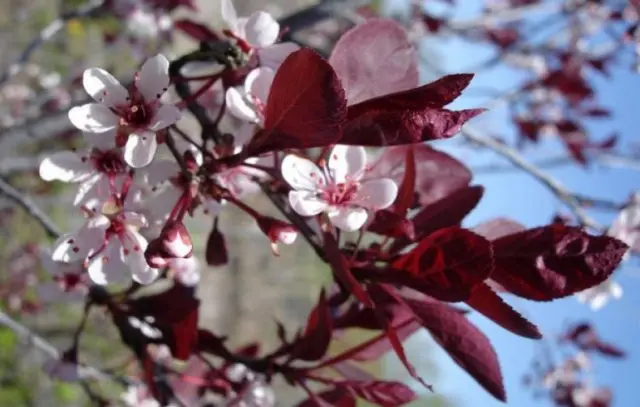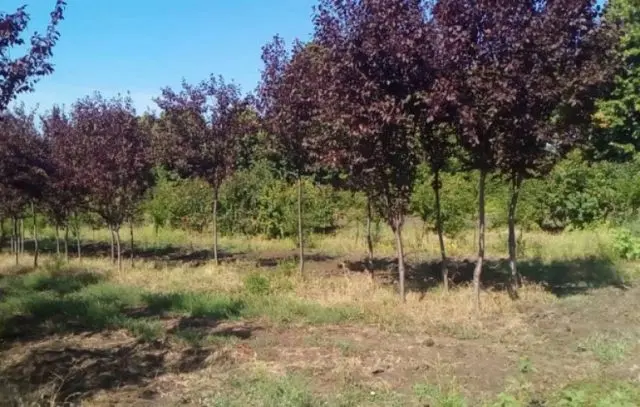Contents
Plum Pissardi is a famous fruit variety among summer residents and landscape designers. The tree is widely used to create a unique site design, adding a bright accent to the garden area. The original color of its crown, non-standard fruits made the plum a popular crop in the southern regions.
History of variety breeding
Botanist Pissard in 1878 brought this variety to Paris from Iran, where the plant had been cultivated for many years before.

Description of the Pissardi plum
Variety Pissardi on the stem. It is called the splayed plum. It belongs to the Rosaceae family. This variety is common in Abkhazia, Georgia, Adjara.
The variety grows as a shrub. Its short trunk is brown. Shrub of medium height. The height of the Pissardi plum is 5-9 m. The crown is sprawling, lush. Shoots maroon. In one year they grow by 20-25 cm.
Leaves are ellipsoid. They attract attention with non-standard coloring. Red-purple overflows with a metallic sheen attract the eye to the crown.
The Pissardi plum is famous for its abundant harvest of juicy fruits of a dark cherry hue. One fruit reaches 3 cm in diameter. Its weight ranges from 20 to 30 g. The shape of the fruit resembles a cherry plum. Hence another name for the variety. The taste of plums for an amateur is sour-tart.

Characteristics of a variety
The characteristics of the Pissardi variety must be taken into account when choosing a place for plums and caring for a tree. They are an important condition for a healthy planting of a fruit plant.
Drought resistance, frost resistance
The variety prefers moderate climatic conditions. He tolerates drought, hot weather normally. Pissardi plum is not resistant to low temperatures. Poorly tolerates cold, frost.
Pissardi plum pollinator
The variety will bring a bountiful harvest in the presence of a number of pollinating trees. They can be Chinese plum, other trees of the Pissardi variety. Plum blossoms in April. Pale pink flowers bloom before the leaves appear on the tree. This process ends in May. The hue of the flowers changes to dark red. Their delicate fragrance spreads throughout the garden. The fruits of the tree ripen in August. Keep on the branches until October.

Yield and fruiting
The yield of the edible Pissardi plum is plentiful. The fruits stay on the tree for almost the entire warm season. From one tree you can collect up to 15 kg of fruit.
Scope of berries
Due to their small size, their specific taste of Pissardi plums is more often used as a decorative element. They are widely used in the medical field. Fruits help increase appetite, cleanse the blood. They are added as an active ingredient in anti-aging masks, scrubs. The tart taste of plums does not interfere with cooking fragrant jam, jam from them.
Disease and pest resistance
Plum splayed Pissardi has a high level of resistance to diseases and pests.
Advantages and disadvantages of the variety
The Pissardi plum has a lot of positive qualities. They are an undeniable advantage over other similar plants:
- Original, unique look. Plum is often used in landscape design as a garden decoration.
- The plant tolerates drought very well.
- High level of resistance to diseases and pests.
- Unpretentiousness. The landing care process will not require a lot of effort, time, additional resources.
The variety has a number of features. They must be taken into account when choosing seedlings of this plum for planting on the site:
- Lack of resistance to frost, winds, drafts.
- Average taste qualities of fruits.
- Neighboring varieties, buildings should be at a considerable distance from the plum. She doesn’t like her immediate neighbors.
Planting and caring for Pissardi’s red-leaved plum
Plum Pissardi is an unpretentious plant. A simple planting and care algorithm is the basis for high-quality growth and a bountiful harvest.
Recommended dates
Planting plum seedlings is recommended in the spring before the buds swell. This will allow young plants to take root in the soil before the onset of cold weather. Autumn time for planting is also favorable. September is the best time. Pissardi cuttings will have time to adapt to environmental conditions.
Choosing the right place
Plum loves the sun. For its landing, you should choose the south side of the site, protected from drafts and winds. The variety does not respond well to excessive soil moisture. The level of groundwater at the landing site should be measured. It should not exceed 1,5 m to the bottom of the hole. If this cannot be avoided, then drainage is laid out on the bottom of the pit. Plum will not be able to grow near other plants. She loves space, loneliness. It is important to take care that there are no unwanted neighbors near the tree.
What crops can and cannot be planted nearby
Planting near the Pissardi plum is undesirable. Too sprawling crowns, roots of other plants can interfere with the tree. At a distance of 5 m, you can land:
- apple tree
- berry bushes;
- evergreen variants of trees, others.
It is strongly not recommended to combine planting pears, raspberries with red-leaved plums.
Selection and preparation of planting material
The landing process will not require significant expenditure of resources and funds. A standard set of materials will be needed two weeks before the expected date of disembarkation:
- shovel for holes;
- soil baking powder;
- fertilizer;
- water;
- peg for garter cutting;
- soft rope.
Landing algorithm
Pissardi plum planting activities are not laborious. It is enough to follow the recommended sequence:
- Hole preparation. Two weeks before planting seedlings, a hole is dug 50 cm deep, 70 cm in diameter. Spread a mixture of soil, fertilizers at the bottom. Leave in this state for 14 days.
- A stake is placed in the center of the hole.
- The plum stalk is set on the side of the piece of wood. The roots are straightened. It is important that they are above ground level. Landing sprinkled with soil, tamped.
- The seedling is tied to a peg.
- A young tree is watered, the earth around is loosened.
Plum Aftercare
When performing simple procedures, the variety will delight with high-quality growth, a plentiful harvest, and a healthy planting. Growing the Pissardi plum includes:
- Watering. It should be regular, plentiful with a frequency of 1 time per week. It takes about 4-5 buckets of water per tree.
- Fertilizer. The first year after planting passes without fertilizer. Feeding starts from the second growing season. In spring, plum prefers potash fertilizers, in autumn – humus.
- Soil care. Be sure to get rid of weeds near the plum. Loosening the soil is an important procedure.
- Branch pruning. It is carried out with two goals – to form a crown, sanitary care. Carried out in the spring. Remove old, dry branches. The plant needs a sufficient amount of sunlight. To do this, remove extra branches.
- Disease prevention, pests.
- Preparation for winter. Plum does not tolerate low temperatures. It is very important to provide him with decent protection for the period of cold weather. Planting is abundantly watered, mulched, covered with straw, peat.
Diseases and pests, methods of control and prevention
Name of the disease, pest | Method of struggle | Prevention |
Mučnistaâ rosa | The use of fungicides is recommended | Preventive measures help prevent the appearance of tree diseases: 1. Timely pruning of the tree. 2. Destruction of damaged branches, leaves. 3. High-quality tree fertilizer to maintain its immunity. 4. Seasonal treatment of the plant with insecticides |
Necrosis of the trunk | The disease is important to detect at an early stage. Affected areas are to be pruned immediately. | |
Leafworms, fruit moth | Insects can cause significant damage to a tree. Special chemicals are used against them. They spray the tree, the area around |
Conclusion
The Pissardi plum is an ornamental fruit variety. Its plantings are widespread in the southern regions. The cherry-bearing variety is used by landscape designers to design plots. The original appearance of the plant will create a unique style for any garden. Small fruits are inexhaustible sources of nutrients and vitamins. An unpretentious plant in care is very popular with gardeners and summer residents.










